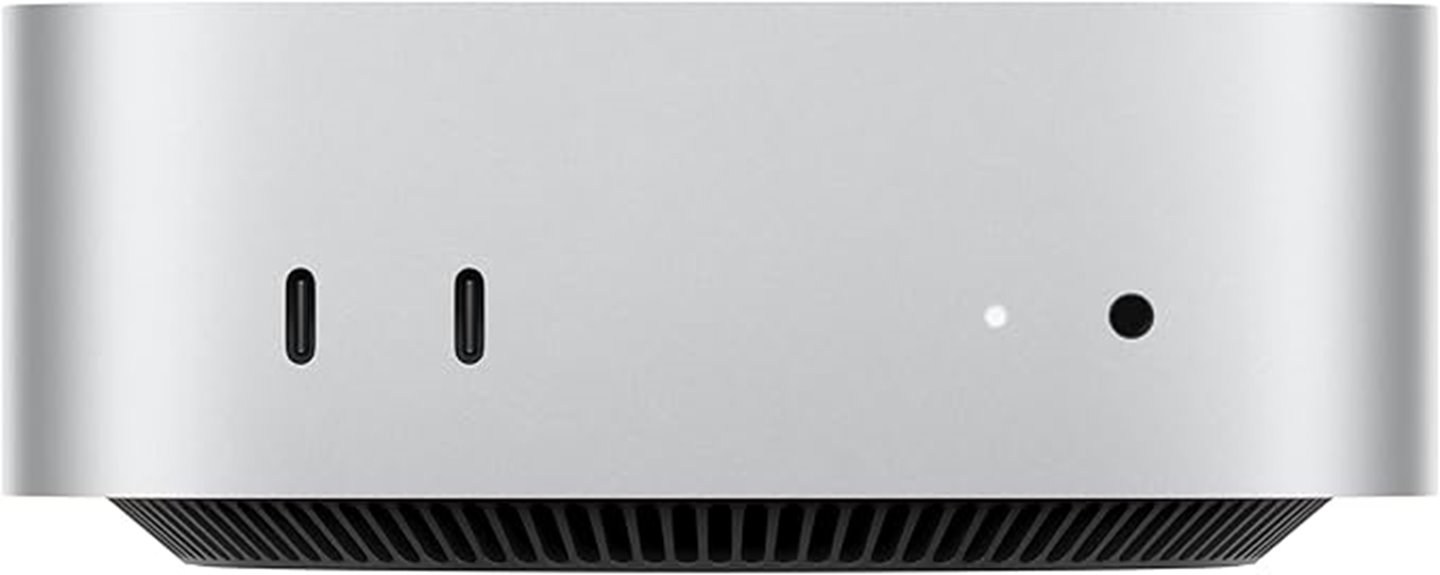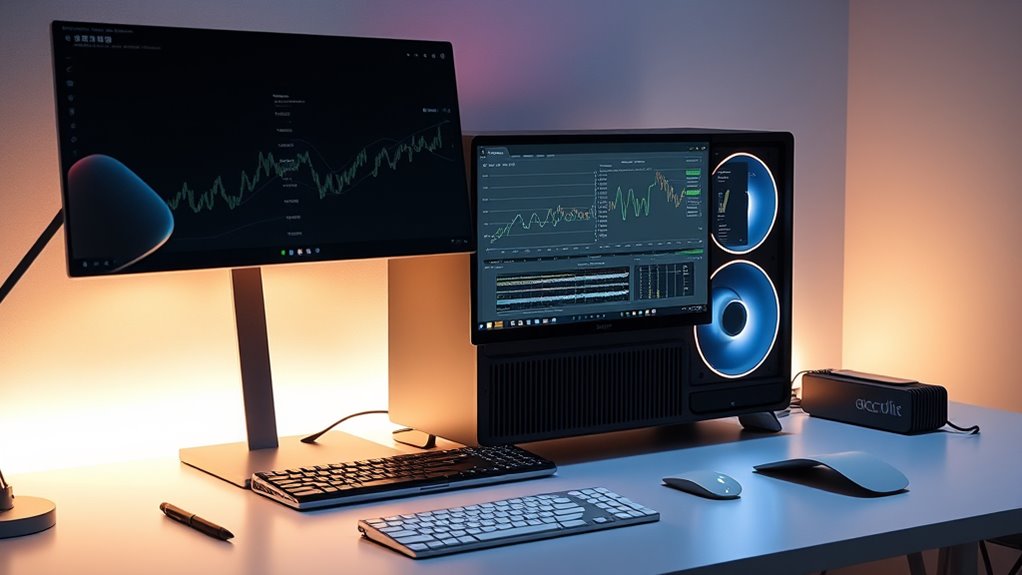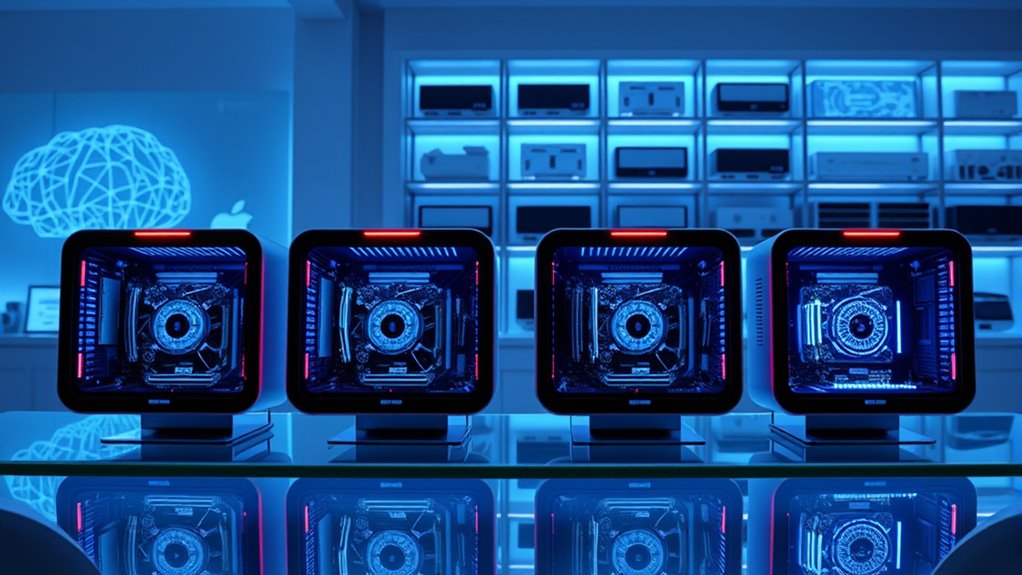If you’re looking for the best Mac Studios for machine learning in 2025, I recommend considering models with the Apple M4 Pro chip, powerful GPU cores, and ample memory like 24GB RAM and fast SSDs. These features guarantee speed, efficiency, and precision for demanding AI tasks. The compact size doesn’t compromise performance, making them perfect for ML workflows. Keep exploring—what follows will help you choose the ideal setup for your needs.
Key Takeaways
- The Mac Studio equipped with the Apple M4 Pro chip offers desktop-level performance in a compact form factor.
- Its 12-core CPU and 16-core GPU deliver powerful processing for demanding machine learning workloads.
- 24GB of unified memory supports extensive datasets and multitasking for advanced ML tasks.
- Versatile connectivity options including Thunderbolt, HDMI, and USB-C facilitate seamless integration with external peripherals.
- Designed for professionals, it ensures speed, efficiency, and privacy for high-performance machine learning in small spaces.
Apple Mac mini Desktop Computer with M4 Pro chip

Are you looking for a compact yet powerful machine learning workstation? The Apple Mac mini with the M4 Pro chip is perfect for that. Despite its small five-by-five-inch size, it packs a 12-core CPU and 16-core GPU, delivering impressive performance. With 24GB of unified memory and a 512GB SSD, it handles multitasking and large datasets effortlessly. Its robust ports, including Thunderbolt and HDMI, support versatile connectivity. Designed for Apple’s ecosystem, it integrates seamlessly with your iPhone and iPad. Whether rendering complex scenes or compiling code, this tiny powerhouse offers speed, efficiency, and privacy—making it an excellent choice for demanding machine learning tasks.
Best For: professionals and enthusiasts seeking a compact, high-performance machine learning workstation that seamlessly integrates with the Apple ecosystem.
Pros:
- Compact size with powerful M4 Pro chip delivers desktop-level performance in a tiny form factor
- Ample 24GB unified memory and 512GB SSD optimize multitasking and large dataset processing
- Seamless integration with iPhone and iPad enhances productivity and user experience
Cons:
- Limited upgrade options due to its integrated design and small size
- May be pricey compared to similarly specced Windows-based mini PCs
- Fewer ports than larger desktops, which might require additional adapters for some peripherals
Apple Mac mini Desktop Computer with M4 Chip

If you’re looking for a compact yet powerful machine to handle demanding machine learning tasks in 2025, the Apple Mac mini with M4 chip stands out. Its 10-core CPU and GPU deliver fast, fluid performance, even with intensive workloads. The 24GB unified memory and 512GB SSD guarantee smooth multitasking and ample storage. Its small size—just 5×5 inches—fits easily beside monitors or anywhere in your workspace. With versatile ports like Thunderbolt, HDMI, and USB-C, you get seamless connectivity. Running macOS optimized for Apple Silicon, it integrates effortlessly with other Apple devices and supports AI-enhanced features, making it a perfect balance of power and portability.
Best For: professionals and power users who need a compact, high-performance desktop capable of handling demanding tasks like machine learning, creative work, and multitasking seamlessly.
Pros:
- Compact size fits easily into any workspace without sacrificing power
- Robust performance with M4 chip, 10-core CPU and GPU, and 24GB memory
- Versatile connectivity options including Thunderbolt, HDMI, and USB-C
Cons:
- Limited upgrade options due to its small, integrated design
- May require additional peripherals or accessories for complete workstation setup
- Higher price point compared to some traditional desktop PCs with similar specs
Apple 2024 Mac mini Desktop Computer with M4 Chip

The Apple 2024 Mac mini with M4 chip stands out as an ideal choice for professionals seeking a compact yet powerful machine learning workstation. Its five-by-five-inch design fits easily next to a monitor, offering space efficiency and portability. Powered by the advanced M4 chip, it features a 10-core CPU, 10-core GPU, and a 16-core Neural Engine, delivering impressive speed and AI capabilities. With up to 32GB of unified memory and fast SSD storage, it handles demanding tasks smoothly. Its quiet operation and robust connectivity, including Thunderbolt 4 and HDMI ports, make it versatile and perfect for ML workflows in small, efficient setups.
Best For: professionals and small teams seeking a compact, high-performance machine learning workstation with powerful AI capabilities and seamless Apple ecosystem integration.
Pros:
- Compact, space-efficient design perfect for small workspaces
- Powerful M4 chip with 10-core CPU, GPU, and Neural Engine for fast AI processing
- Quiet operation and excellent connectivity options, including Thunderbolt 4 and HDMI
Cons:
- Limited RAM and storage upgrade options; external drives recommended for additional capacity
- Only supports up to 32GB of unified memory, which may be insufficient for extremely demanding workloads
- Relatively high price point compared to other small-form-factor PCs
Apple Mac mini Desktop Computer with M4 Chip (512GB SSD, 16GB RAM)

For those seeking a compact yet powerful desktop for machine learning tasks in 2025, the Apple Mac mini with M4 chip stands out thanks to its impressive performance and versatile connectivity. Its sleek, five-by-five-inch design fits well in small spaces and remains quiet even under load. Powered by the M4 chip with a 10-core CPU and GPU, plus 16GB of unified memory, it handles app launches, data transfers, and light video editing effortlessly. Supporting up to three displays with 8K resolution, it’s ideal for multitasking. The extensive port selection, including Thunderbolt 4 and HDMI, guarantees seamless connectivity, making it a reliable, space-saving choice for AI and ML workflows.
Best For: users seeking a compact, high-performance desktop for multitasking, content creation, and AI/ML workflows in small spaces.
Pros:
- Sleek, space-efficient design that fits easily in tight workspaces
- Powerful M4 chip with 10-core CPU and GPU for demanding tasks
- Supports up to three high-resolution displays, ideal for multitasking
Cons:
- Non-upgradable RAM and storage limit future expandability
- May require external drives for additional storage needs
- Some users report setup challenges with external monitors or cables
Factors to Consider When Choosing a Mac Studio for Machine Learning

When selecting a Mac Studio for machine learning, I focus on processing power and memory capacity to handle demanding tasks smoothly. GPU performance is critical for accelerating computations, while storage options need to match project sizes. Additionally, ensuring compatibility with your preferred ML tools is essential for a seamless workflow.
Processing Power Needs
Processing power is a essential factor when choosing a Mac Studio for machine learning, as it directly affects training speed and efficiency. High processing capabilities are indispensable for handling complex computations and large datasets. The number of CPU and GPU cores plays a pivotal role; more cores mean faster processing and shorter training times for deep learning models. Additionally, memory bandwidth and total RAM are indispensable for managing extensive datasets and model parameters without bottlenecks. Hardware-accelerated features, like neural engines and specialized AI cores, further boost performance, enabling smoother workflows. When selecting a Mac Studio, prioritize models with powerful processors and ample cores to guarantee your machine learning tasks run swiftly and efficiently. This focus on processing power ultimately determines how quickly and effectively you can develop and deploy models.
Memory Capacity Importance
Having enough memory capacity is essential because it directly influences your ability to handle larger datasets and more complex models without slowing down. When you have sufficient RAM, you can process bigger data sets and run more demanding machine learning tasks simultaneously, boosting productivity. Higher RAM also reduces the need for data swapping between memory and storage, which speeds up training times considerably. For deep learning, especially with large neural networks, 16GB or more of unified memory is recommended to efficiently manage model parameters. Upgrading your Mac Studio’s memory not only improves current performance but also future-proofs your setup against increasing model sizes and evolving frameworks. In short, ample memory ensures smoother workflows and faster results in your machine learning projects.
GPU Performance Factors
Choosing the right GPU for your Mac Studio is essential because its performance directly impacts how efficiently you can train and run complex machine learning models. The number of cores and the GPU’s architecture primarily determine its parallel processing power, which is pivotal for tasks like deep learning. Higher core counts and newer architectures enable faster matrix computations and better support for frameworks like TensorFlow and PyTorch. Dedicated hardware-accelerated ray tracing and neural engines can further boost efficiency by offloading intensive tasks. Additionally, GPU memory bandwidth and VRAM size are key—they allow handling large datasets and complex models without bottlenecks. Compatibility with acceleration APIs like Metal ensures smooth integration with machine learning libraries, making these factors indispensable in selecting a high-performance Mac Studio.
Storage Options Variability
Selecting the right storage options for your Mac Studio can make a significant difference in how smoothly your machine learning workflows run. Storage configurations typically range from 512GB to 2TB SSDs, affecting both capacity and performance. Larger SSDs provide more space for extensive datasets and faster data access, which is vital for efficient machine learning tasks. However, higher storage capacities also come with increased costs, so balancing your budget with your data needs is essential. Some models support external storage solutions, offering flexibility for future expansion. When choosing, consider your current and projected data requirements, whether internal upgrades suffice, or if external drives will meet your growth. Making an informed decision here ensures your Mac Studio remains capable and responsive as your machine learning projects evolve.
Compatibility With ML Tools
To guarantee your Mac Studio handles machine learning tasks efficiently, it’s vital to verify that its hardware and software components are compatible with popular ML frameworks. Make sure it has a GPU like the M4 Pro or higher to speed up computations. Check that macOS supports frameworks such as TensorFlow, PyTorch, and Core ML for smooth integration. Adequate RAM—24GB or more—is essential to manage large datasets and complex models without bottlenecks. Hardware acceleration features like neural engines and hardware-accelerated ray tracing should be optimized for ML workloads. Additionally, confirm that connectivity options support external GPU enclosures or high-speed storage devices, which can expand processing capabilities. Compatibility across these elements ensures your Mac Studio can effectively handle demanding machine learning tasks.
Connectivity and Expansion
Ensuring your Mac Studio can expand and connect seamlessly is key to optimizing machine learning workflows. I look for multiple Thunderbolt 4 and USB-C ports to connect high-speed external drives, GPUs, and peripherals essential for handling large datasets and intensive tasks. An Ethernet port or support for 10Gb Ethernet is imperative for fast data transfer and network-heavy operations. Support for multiple high-resolution displays, up to 8K via Thunderbolt and HDMI, enhances visualization of datasets and training models. I also consider external storage options like SSDs to manage large datasets efficiently without overloading internal storage. Additionally, compatibility with external GPU enclosures and expansion modules can greatly boost processing power for demanding ML computations, ensuring my workflow remains smooth and scalable.
Power Efficiency Benefits
Have you considered how power efficiency impacts your machine learning setup? Efficient power use reduces energy costs, making long training sessions more affordable. It also minimizes thermal stress, which helps extend your Mac Studio’s lifespan by preventing heat-related wear. When a system is more power-efficient, it can sustain high-performance workloads longer without needing excessive cooling, reducing noise and maintenance. For portable setups, improved energy management is vital, as it allows for longer training sessions on battery power without frequent recharging. Plus, choosing a power-efficient Mac Studio supports sustainable computing practices, lowering your environmental footprint during intensive machine learning tasks. Overall, prioritizing power efficiency ensures your setup is cost-effective, durable, and capable of handling demanding workloads reliably.
Ecosystem Integration Benefits
Power efficiency is vital for cost-effective and reliable machine learning setups, but equally important is how well a Mac Studio integrates with your existing Apple devices. Seamless ecosystem integration means I can effortlessly connect my iPhone or iPad, streamlining workflows and reducing setup time. Features like iPhone Mirroring, message sharing, and FaceTime control allow quick data transfers and communication without additional software, saving valuable time. Compatibility with macOS and native Apple Silicon support ensures that all my machine learning frameworks and tools run smoothly within the ecosystem. Plus, Apple’s focus on secure, private data handling across devices gives me peace of mind for sensitive projects. Overall, tight integration helps me focus on developing models rather than troubleshooting system configurations.
Frequently Asked Questions
How Does Thermal Management Affect Long-Term Machine Learning Tasks on Mac Studios?
Thermal management critically impacts long-term machine learning tasks on Mac Studios because it helps prevent overheating that can throttle performance. When temps stay ideal, I notice consistent processing speeds and reliability, reducing errors or crashes. Good cooling means my Mac can run intensive models all day without slowing down, ensuring my work remains accurate and efficient. Proper thermal design is key to maintaining peak performance during extended machine learning sessions.
What Are the Upgrade Options for Future-Proofing Mac Studios for AI Workloads?
I’d suggest focusing on upgrading RAM and storage, as these directly impact AI workload efficiency. Opt for models that support higher memory capacities and faster SSDs. Additionally, consider external GPU options if compatible, to boost processing power. Keep an eye on Apple’s latest chip advancements and future-proof configurations, so your Mac Studio can handle evolving AI tasks without becoming obsolete too quickly. Upgrading these components guarantees smoother, more reliable machine learning performance.
How Do Software Compatibility Issues Impact Machine Learning Performance on Mac Studios?
Software compatibility issues can considerably impact machine learning performance on Mac Studios. When AI tools and libraries aren’t optimized for macOS or the latest hardware, I notice slower processing speeds or errors. It’s frustrating, but I mitigate this by regularly updating software, using compatibility layers like virtualization, or switching to alternative tools. Staying current with updates helps make certain my machine learning workflows run smoothly and efficiently.
What Is the Expected Lifespan of Mac Studios in High-Demand AI Applications?
Think of a Mac Studio like a reliable marathon runner—built to last, but not immortal. In high-demand AI tasks, I expect it to stay effective for about 3 to 5 years, depending on software updates and workload intensity. Its cutting-edge hardware can handle intense AI workloads, but over time, newer models with advanced chips will likely outpace it. Still, it remains a powerful tool for quite a while.
How Does the Integration of External GPUS Enhance Mac Studio Machine Learning Capabilities?
Integrating external GPUs considerably boosts my Mac Studio’s machine learning capabilities by providing extra processing power and faster data handling. I connect high-performance eGPUs, which accelerate model training and inference, reducing wait times and increasing productivity. This setup is especially helpful for complex algorithms and large datasets, making my workflow smoother and more efficient. It’s like giving my Mac Studio a powerful upgrade without needing a new machine.
Conclusion
Choosing the right Mac Studio is like planting a seed—you need the right foundation to grow strong. With power, performance, and precision in mind, the options I’ve shared will help you nurture your machine learning projects. Remember, “a journey of a thousand miles begins with a single step.” So, pick the one that best fits your needs, and watch your ideas blossom into reality. Your perfect Mac Studio awaits—ready to fuel your success.









